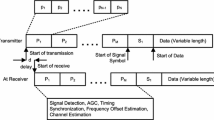Abstract
A hardware-efficient algorithm and architecture for computing Zadoff–Chu (ZC) sequence elements on-line using the CORDIC algorithm are proposed. Zadoff–Chu sequences possess good correlation properties that are essential in a variety of engineering applications, such as establishing timing synchronization between a mobile terminal and a base station in the emerging 3GPP long-term evolution (LTE) physical layer standard for cellular communications. The proposed algorithm computes ZC-sequence elements both in time domain and frequency domain using a simple duality relationship. Algorithm transforms are employed to compute the elements recursively and eliminate the need for multipliers with non-constant terms. A reconfigurable hardware architecture was implemented and applied in a searcher block for detecting the physical random access channel (PRACH) in LTE. The PRACH provides a mechanism for a mobile to establish initial access along with uplink synchronization by transmitting a preamble that is constructed from ZC sequences. The proposed architecture is capable of generating these preambles on the fly with high accuracy, eliminating the need for storing a large number of long complex-valued ZC sequence elements. Simulation results demonstrate that the proposed architecture is capable of achieving detection error rates for LTE PRACH that are close to ideal rates achieved using floating point precision. (The work has been presented in part in Mansour (2009).)





Similar content being viewed by others
References
Mansour, M.M. (2009). Optimized architecture for computing Zadoff–Chu sequences with application to LTE. In Proc. IEEE Int. global communications conference, Honolulu, Hawaii, USA (pp. 1–6).
3GPP TS 36.211 V8.2.0 (2008). 3rd Generation Partnership Project; Technical specification group Radio Access Network; Evolved Universal Terrestrial Radio Access (E-UTRA); Physical Channels and Modulation (Release 8).
Chu, D. (1972). Polyphase codes with good periodic correlation properties. IEEE Transactions on Information Theory, IT-18, 531–532.
Kantabutra, V. (1996). On hardware for computing exponential and trigonometric functions. IEEE Transactions on Computers, 45(3), 328–339.
Volder, J.E. (1959). The CORDIC trigonometric computing technique. IRE Transactions on Electronic Computers, 8, 330–334.
Sarwate, D.V. (1979). Bounds on crosscorrelation and autocorrelation of sequences. IEEE Transactions on Information Theory, IT-25, 720–724.
Li, C.-P. & Huang, W.-C. (2007). A constructive representation for the Fourier dual of the Zadoff–Chu sequences. IEEE Transactions on Information Theory, 53(11), 4221–4224.
Dahlman, E., et al. (2007). 3G evolution: HSPA and LTE for mobile broadband. London, UK: Academic Press.
Beyme, S., & Leung, C. (2009). Efficient computation of DFT of Zadoff-chu sequences. Electronics Letters, 45(9), 461–463.
Popovic, B.M. (2010). Efficient DFT of Zadoff–Chu sequences. Electronics Letters, 46(7), 502–503.
Ercegovac, M., & Lang, T. (1990). Redundant and on-line CORDIC: application to matrix triangularization and SVD. IEEE Transactions on Computers, 6, 725–740.
Hu, X., Bass, S.C., Harber, R.G. (1993). An efficient implementation of singular value decomposition rotation transformations with CORDIC processor. Journal of Parallel and Distributed Computing, 17, 360–362.
Lang, T., & Antelo, E. (2001). High-throughput 3D rotations and normalizations. In Proc. of Asilomar conf. signals, systems, computers (Vol. 1, pp. 846–851).
Hu, Y.H., & Wu, Z. (1995). An efficient CORDIC array structure for the implementation of discrete cosine transform. IEEE Transactions on Signal Processing, 43, 331–336.
de Lange, A.A.J., et al. (1990). Real time applications of the floating point pipeline CORDIC processor in massive-parallel pipelined DSP algorithms. In Proc. int. conf. acoustics, speech, sig. proc. (Vol. 2, pp. 1013–1016).
Kim, S., Joo, K., Lim, Y. (2012). A delay-robust random access preamble detection algorithm for LTE system. In Radio and wireless symposium (RWS), 2012 IEEE (pp. 75–78).
Author information
Authors and Affiliations
Corresponding author
Appendix
Appendix
Proof of Theorem 1
The DFT of the ZC sequence in Eq. 1 is given by \(Z_{\gamma}[k] \!=\! \sum_{n=0}^{N-1} \exp{\!\big(-j\frac{2\pi\gamma}{N} \frac{n(n+1)}{2}\big)}\,\times \exp{\!\left(-j\frac{2\pi k n}{N}\right)}\). Since \(\gamma'\gamma \bmod{N} \!=\!1\), we can replace k by γγ′ k in the last exponential and obtain \( Z_{\gamma}[k] \!=\! \sum_{n=0}^{N-1} \exp{\!\big(-j\frac{2\pi\gamma}{N} \frac{n(n+1)}{2}\big)}\!\times\exp{\!\big(-j\frac{2\pi\gamma\gamma' k n}{N}\big)}\). Combining the arguments of the exponentials and completing the squares with respect to g = (n + γ′k), we obtain:
□
Rights and permissions
About this article
Cite this article
Mansour, M.M. A Hardware-Efficient Algorithm for Real-Time Computation of Zadoff–Chu Sequences. J Sign Process Syst 70, 209–218 (2013). https://doi.org/10.1007/s11265-012-0705-3
Received:
Revised:
Accepted:
Published:
Issue Date:
DOI: https://doi.org/10.1007/s11265-012-0705-3




